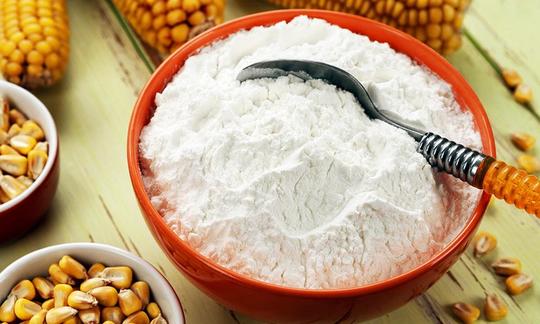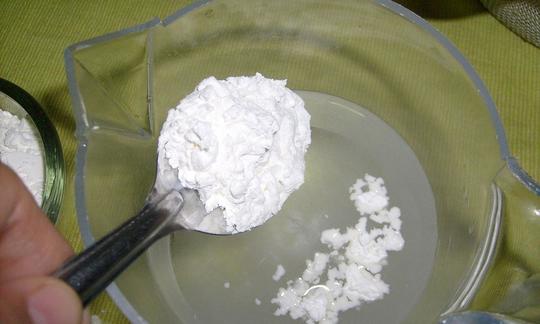Table of contents
What is corn starch? Corn starch (lat. Maydis amylum) is modified starch: a carbohydrate (polysaccharide) that is used in the food industry primarily as a thickener. Organic corn starch is more advisable.
Use in the kitchen
The term food starch is used almost exclusively for starch made from corn. Pure starch also exists from potatoes or as cereal starch (especially from wheat), which was common in the past. Today, corn is the predominant raw material. Food starch and corn starch are therefore not always the same thing.
The physically modified starch can be used in many different ways in cooking and baking due to its neutral odor and taste. On the one hand, the starch serves as a sauce thickener to thicken savory or sweet sauces. On the other hand, it can be used for gluten-free baking. If you use it to replace some of the gluten-free flour varieties that lack binding and sticking power, you can use it to bake cakes.
One advantage is that corn starch does not clump when mixed with cold water, like flour, for example. If you slowly stir this liquid into the hot sauce, the small grains swell up and bind the liquid to form a thick paste. 1 This process is known as gelatinization.
Corn starch can also be found in many ready-made products such as soups, sauces, creams, puddings and baby food (follow-on milk). Avoid such products if possible. Their origin and production method can usually no longer be traced.
Is corn starch healthy? Although corn starch is convenient, inexpensive and almost always produces positive results, it is not very healthy and should not be used too often. Modified starch is a mechanical or chemical extract and therefore very poor in essential nutrients. During digestion, the body breaks down the numerous carbohydrates into other polysaccharides and finally into glucose (i.e. sugar). Chemically modified starch contains phosphoric acid. Is corn starch unhealthy? Not directly, we explain that below.
What can I use instead of corn starch? There are alternative binding agents such as rice starch or cassava starch (tapioca starch) as possible replacements, both of which are economically important. Healthier alternatives for thickening include psyllium husks (rich in fiber), chia gel made from chia seeds (rich in omega-3 fatty acids, fiber and antioxidants), guar gum from guar beans, locust bean gum from the seeds of the carob tree, wholemeal flour or a finely grated, boiled potato.
Vegan recipe for vanilla pudding with corn starch
Ingredients (4 servings): 500 ml almond milk, 40 g corn starch, 50 g powdered sugar, 2 packets of vanilla sugar, 2 vanilla pods.
Preparation: Mix the cornstarch and icing sugar with about 50 ml of almond milk. Bring the remaining almond milk to the boil with the vanilla sugar, the pulp of the vanilla pods and the whole pods. As soon as the plant milk boils, remove the vanilla pods and stir in the cornstarch-icing sugar mixture. Simmer over a low heat, stirring constantly, until the mixture has thickened. Pour the vanilla pudding into small bowls and leave to cool or enjoy warm straight away.
Vegan recipes with corn starch can be found under the note: " Recipes that have the most of this ingredient ".
| Not only vegans or vegetarians should read this: Vegans often eat unhealthily. Avoidable nutritional errors. |
Purchasing - Storage
Corn starch is available at all supermarket chains such as Coop, Migros, Denner, Volg, Spar, Aldi, Lidl, Rewe, Edeka, Billa, Hofer etc. There you will find industrial branded products made from pure, mostly gluten-free corn starch.
In organic supermarkets (e.g. Denn's Biomarkt and Alnatura), drugstores, health food stores or online shops you can also buy starch products from other plants, such as potato starch, tapioca starch flour etc. They are also available in organic quality. With conventional corn starch, the original product can also come from genetically modified corn. Not only corn from the USA and Argentina can be genetically modified, but also in Europe certain ingredients from genetically modified corn are permitted, even if they do not have to be labelled. 1 However, the topic of genetically modified plants needs to be considered in a differentiated way and goes beyond the scope of this article. 18 We generally recommend organic corn starch.
The availability of cornstarch varies depending on the size of the store, catchment area, etc. Our recorded food prices for the DA-CH countries can be found above under the ingredient image - and by clicking you can see their development at various suppliers.
Storage tips
Corn starch is best stored in a cool, dry place in well-sealable containers made of metal or glass. This not only protects against pests, but also against foreign odors. Under optimal storage conditions, corn starch will last for several years.
Ingredients - Nutritional values - Calories
Cornstarch has an energy content of about 381 kcal/100g, which comes mainly from carbohydrates (91%). The protein content is very low at 0.25% and fat is practically non-existent at 0.05%. 2
Physically modified starch contains hardly any essential nutrients. Copper, selenium, iron and manganese each provide less than 5% of the daily requirement per 100 g. 2
The complete ingredients of corn starch, the coverage of the daily requirement and comparison values with other ingredients can be found in our nutrient tables. In the article Nutrients explained you will get a detailed insight into the topic.
Effects on health
Is corn starch healthy? Medicine also makes use of starch. Uncooked corn starch is needed for specific metabolic disorders (glycogen storage diseases) in which the release of glycogen reserves from the liver is impaired. Since the body digests uncooked corn starch very slowly, blood sugar levels can be kept constant for several hours. Without food, patients would soon experience hypoglycemia. 3,4
Phosphoric acid is an important ingredient in chemically modified types of starch. This is said to promote the development of diseases such as osteoporosis and heart disease. People with kidney disease should avoid foods containing this substance. Calcification and inflammation can also form within the bloodstream, which in turn promotes cardiovascular disease. The list of possible diseases caused by the consumption of modified starch is constantly growing. 5
Secondary plant substances
Secondary plant substances are not relevant to the nutritional profile of corn starch. Find out more about the importance and classification of these bioactive substances in foods in the article on secondary plant substances.
For more information about the phytochemicals in corn, the basis for corn starch, see our article about this ingredient.
Dangers - Intolerances - Side effects
People with gluten intolerance or celiac disease should always look for the gluten-free symbol, a crossed-out ear of corn, when buying corn starch. Is corn starch lactose-free? Corn products are usually lactose-free and gluten-free, but always find out more about the product you are buying. According to EU law, gluten-free wheat starch may contain a maximum of 20 mg/kg of gluten. 6 In rare cases, very sensitive people experience symptoms even with these small amounts. People who are allergic to wheat should switch to other starch products.
Overheating starch (from around 170 °C), especially when baking, roasting, grilling and deep-frying, produces acrylamide, which is classified as carcinogenic. If you use corn starch for baking, you should be aware of this. If you thicken sauces with starch, you are operating at temperatures below these levels.
The food industry mixes corn starch not only into baked goods and sweets, but also into dairy products and drinks - in the form of starch-based sugars (glucose syrup, dextrose, isoglucose). In the processed form of the controversial corn syrup (HFCS), starch can also be found in ice cream, jams and other sweets.
Physically modified starch may also be present in organic products. Enzymatically or chemically modified starch types are declared as E numbers E1400 - E1451 and are not permitted in organic products. 1
Ecological footprint - animal welfare
The starch production process is expensive, water-, time- and energy-intensive. Chemicals such as sulphurous acid are also often used. Sulphurous acid (H 2 SO 3) is one of the six most common air pollutants and has a negative impact on the environment. Improvements have already been made, but the problem is not yet solved. 17
Corn starch nevertheless appears to be relatively climate-friendly. 19 According to Carboncloud, corn starch has a CO 2 footprint of around 0.95-1.01 kg CO 2 eq/kg, wheat starch 0.59 kg CO 2 eq/kg and potato starch 1.61 kg CO 2 eq/kg. 20
The global average water footprint is 1436 l/kg for wheat starch, 1671 l/kg for maize starch, 1512 l/kg for potato starch and 2254 l/kg for cassava starch. These are not dramatically high values – grain comes to 1644 l/kg. In each case, the 'green water' makes up the largest part. This means that rainwater is the main contributor to the water supply. It should be remembered that in areas with little rain, this water footprint has other effects. Water consumption then competes with other economic and household activities. In comparison to potatoes with 191 l/kg, starch performs very poorly. 21
For detailed explanations of various sustainability indicators (such as ecological footprint, CO2 footprint, water footprint), see our article: What does the ecological footprint mean?
Animal welfare - species protection
The loss of biodiversity is one of the biggest global environmental problems caused by human activity. Intensive agriculture and the increased cultivation of monocultures are the main reasons for the loss of species. A study on the effects of corn cultivation showed that intensive cultivation of monocultures still had a negative impact on biodiversity even after 30 years of cultivation being stopped. 22 For example, bumblebees are threatened by corn monocultures. 12
The Loss of biodiversity is accompanied by the loss of ecosystem services on which our agriculture depends. 23
Worldwide occurrence - cultivation
What is corn starch made of? The majority of the corn starch available on the market today is made from corn ( Zea mays). It is mainly produced in the United States, China, Brazil and Argentina. 7 In 1492, Columbus discovered the corn plant in Cuba, so it was assumed that this was also where it originated. 8
The origin of corn is still not entirely clear. Corn probably originated from the wild plant called 'teosinte', which is not edible. 15 Researchers assume that corn was first cultivated in Mexico around 3,000 BC. 16
The use of starch can be traced back to 3500 BC. In the forerunner of paper, papyrus sheets, researchers were able to detect traces of starch adhesives. For thousands of years, starch was probably mainly used for applications such as these. It was not until the 18th century that people began to use corn to produce starch. In the course of this development, starch slowly found its way into food production. Today, it can be assumed that only a third of the starch produced is used in the technical-industrial sector; two thirds are used in the food sector. 11
Roughly speaking, there are two types of starch on the market. Firstly, native starch, which is obtained through natural extraction; and secondly, modified starch, which is produced through enzymatic, physical or chemical processes. The latter play a larger role in the food industry due to their functional properties. 11
Cultivation - Harvesting
Maize as a root crop loosens up crop rotations that focus on cereals. In organic farming, maize is a demanding plant in terms of nutrient supply and weed control. To prevent erosion, nutrient leaching and soil compaction, organic quality requires good management and wide crop rotations. 9
As a summer crop, corn needs warm, deep, nutrient-rich and humus-rich soil with a regular water supply. The best time to grow it is late April to mid-May, depending on the location and climate. Corn is also known as a C4 plant because it can convert carbon more efficiently than other crops. Corn is also more tolerant of heat stress and water shortages.
This cereal plant, which belongs to the sweet grass family, produces a very high yield in good years. Grain maize is harvested in mid-October. Although maize is largely self-compatible, growing the same crop the following year is generally not permitted in organic farming. In addition, a close crop rotation encourages a particularly feared pest: the corn rootworm ( Diabrotica virgifera virgifera). This can cause enormous damage and crop failures. In organic farming, attempts are made to counteract this pest with pheromone traps and the use of nematodes or other natural enemies. A cultivation break of at least 3 years should be observed.
Another pest is the European corn borer ( Ostrinia nubilalis), whose caterpillars can reduce yields by up to 30%. Optimal post-harvest management and undersowing that promotes beneficial insects have a positive effect here. A direct measure of biological pest control is the use of Trichogramma parasitic wasps, which parasitize the European corn borer caterpillars. 9
Genetically modified corn varieties have been in circulation since the end of 1990. Since 2009, 19 countries, including the USA, Brazil, Argentina and Canada, have been growing these pest and herbicide resistant varieties. The proportion of transgenic corn varieties in the USA is now 85%. 10
Industrial production
The corn plant stores its energy in the form of polysaccharides in the cells. This native (natural) starch represents the plant's reserve substance and is comparable to the glycogen stored in the human body.
Physically modified starch is considered to be the same as native starch because it is only thermally treated. It is also called instant starch, cold-swelling starch, pregelatinized starch or pregelatinized starch.
Once again: What is corn starch? Corn starch should not be confused with corn flour, the manufacturing process is much more complicated: the degerminated, swollen grain is separated from the starch it contains using a saline solution in a multi-stage washing process. Corn is soaked four to five times for 24 hours each in water at 35°C. After "washing", the corn is wet-ground twice. Mixed with water, the coarse bran is filtered out. The starch is pressed through fine silk fabric. The starch is deposited on slightly inclined slates 80-100 m long. The drained water, which hardly contains any starch, is pressed into cakes and used as animal feed.
Chemically modified starches are food additives: they are chemically modified and must be declared as E1400 to E1451. The treatment is carried out with acids (eg sulphurous acid) 17, bases, bleaching agents, enzymes, etc. This process makes starch more stable when treated with heat, acids or when frozen, and is therefore more interesting for industry.
The oldest description (ca. 200 BC) of the production of starch is as follows: Wheat grains were poured with fresh water twice a day for ten days in a hollow. After the swelling process, the mass was drained by squeezing, the resulting liquid was mixed again and pressed out again using linen bags. The starch contained in the press water was created by drying in the sun. In addition, any bran that floated to the top was sieved off. 11
Further information
Starch is an organic compound consisting of α-D-glucose units and has the formula C 6 H 10 O 5. The amylose contained in the starch turns blue when iodine is added. This process is reversible. 13
Alternative names
Alternative names, common names, in English, drug names, etc.
In English, starch is called 'starch' or 'modified starch'. Corn starch is known as 'corn starch' or 'maize starch'.
Other applications
Corn starch has many applications in the technical industry. 11
It is also used as a renewable raw material for chemical-technical manufacturing processes, e.g. for paper or corrugated cardboard made from paper starch. There are packaging flakes made from corn starch, spoons made from corn starch, carrier bags made from corn starch, etc. Starch is also an important material in the fermentation industry for platform chemicals and bioethanol. In the USA in particular, corn starch is the number one material for the production of biofuel, in Germany it is wheat, and in Brazil sugar cane is used.
Bio-based plastics in the form of thermoplastic starch or starch-duroplast as foamed cushioning material in packages are a relatively new area of application. These materials (PLA, polylactide) are compostable and made from renewable raw materials. 14
In pharmacy, starch is used as a filler, disintegrant, binder in tablets and as a powder base. 11
Bibliography - 23 Sources
| 1. | Pini U. Das Bio-Food Handbuch. Ullmann: Hamburg, Potsdam. 2014. |
| 2. | USDA United States Department of Agriculture. |
| 3. | Chen MA, Weinstein DA. Glycogen storage diseases: Diagnosis, treatment and outcome. Translational Science of Rare Diseases. 2016;1(1):45-72. |
| 4. | Biesalski HK, Bischoff SC, Pirlich M et al. Ernährungsmedizin. 5. Auflage. Thieme: Stuttgart, New York. 2018. |
| 5. | Grimm HU, Ubbenhorst B. Chemie im Essen: Lebensmittel-Zusatzstoffe: Wie sie wirken, warum sie schaden [E-Book]. Knaur. 2023:1216. |
| 6. | Amtsblatt der Europäischen Union. Verordnung (EG) Nr. 41/2009 der KOMMISSION vom 20. Januar 2009 zur Zusammensetzung und Kennzeichnung von Lebensmitteln, die für Menschen mit einer Glutenunverträglichkeit geeignet sind. |
| 7. | FAO Food and Agriculture Organization of the United Nations. Faostat: Crops and livestock products, Production quantity. 2022. |
| 8. | Brücher H. Tropische Nutzpflanze. Ursprung, Evolution und Domestikation. Springer: Berlin, Heidelberg, New York. 1977. |
| 9. | Dierauer H, Gelencsér T. Merkblatt Biomais. FIBL Forschungsinstitut für Biologischen Landbau. Nr. 1017. 2019. |
| 10. | Brookes G, Barfoot P. Global impact of biotech crops: Socio-economic and environmental effects in the first ten years of commercial use. AgBioForum. 2006;9(3):21-38. |
| 11. | Tegge PDG. Stärke und Stärkederivate. Behr’s Verlag DE; 2004:1-4, 215-219. |
| 12. | Hass AL, Brachmann L et al. Maize‐dominated landscapes reduce bumblebee colony growth through pollen diversity loss. Journal of Applied Ecology. 2019;56(2):294-304. |
| 13. | Kemnitz E, Simon R. Duden - Abiturwissen Chemie. 2. aktualisierte Auflage. Dudenverlag Mannheim: Mannheim. 2007. |
| 14. | FNR Fachagentur. Nachwachsende Rohstoffe. Biokunststoffe. 6. Auflage. 2019. |
| 15. | Wang H, Nussbaum-Wagler T et al. The origin of the naked grains of maize. Nature. 2005;436(7051):714-719. |
| 16. | Rimbach G, Möhring J, Erbersdobler HF. Lebensmittel-Warenkunde Für Einsteiger. Springer Berlin Heidelberg; 2010. |
| 17. | Yu JK, Moon YS. Corn starch: quality and quantity improvement for industrial uses. Plants. 2021;11(1):92. |
| 18. | Vega Rodríguez A, Rodríguez-Oramas C et al. Myths and realities about genetically modified food: a risk-benefit analysis. Applied Sciences. 2022;12(6):2861. |
| 19. | Greenpeace Schweiz, Stadt Zürich, Planted Foods AG, Branding Cuisine, Tinkerbelle, Inge, myblueplanet, ProVeg International, Dr. Earth, FightBack und Eaternity. All You Can Eatfor climate - Poster. ayce.earth. 2022. |
| 20. | Carboncloud. Sweden. Corn starch. Wheat starch. Potato starch. |
| 21. | Mekonnen MM, Hoekstra AY. The green, blue and grey water footprint of crops and derived crop products. Hydrol Earth Syst Sci. 2011;15(5):1577–1600. |
| 22. | Fuchs A. The long-term effects of monoculture maize cultivation on plant diversity. Phytocoenologia. 2021; Vol.50(4):397-408. |
| 23. | Capellesso AJ, Cazella AA et al. Economic and environmental impacts of production intensification in agriculture: comparing transgenic, conventional, and agroecological maize crops. Agroecology and Sustainable Food Systems. 2016;40(3):215-236. |













Comments